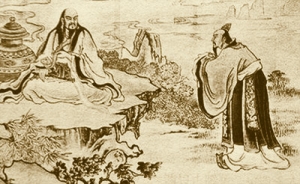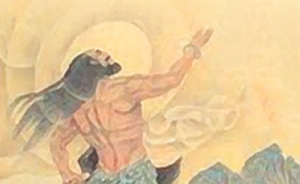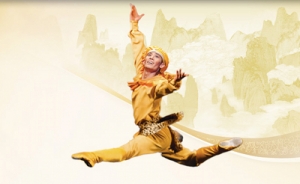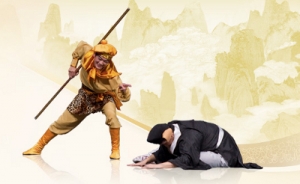Quan Âm Bồ Tát đại từ bi

Quan Âm Bồ Tát.
Quan Âm Bồ Tát mặc y phục trắng, đứng trên tòa sen, một tay cầm nhành dương liễu, một tay nâng bình tịnh thủy, bà còn được biết đến là Quan Âm Từ Mẫu.
Ý nghĩa của tên “Quan Âm” chính là “lắng nghe thống khổ trên thế gian bằng trái tim.” “Bồ Tát” là chỉ quả vị ở cảnh giới trên La Hán và dưới Phật Đà.
Truyền thuyết về Quan Âm Bồ Tát xuất hiện cách đây hơn 2.000 năm trước ở Trung Quốc cổ đại. Vào khoảng thời nhà Tống (960 – 1279 SCN), Quan Âm Bồ Tát đã được nhiều người biết đến và được tôn thờ như “một vị Thần đại từ đại bi” cho đến ngày nay.
Dưới đây chúng tôi xin giới thiệu một trong những câu chuyện nguyên gốc về Quan Âm Bồ Tát.
Truyền thuyết về Công chúa Diệu Thiện
Ngày xưa, ở nước Hưng Lâm thuộc Trung Quốc có ba nàng công chúa. Vì để bành trướng thế lực, quốc vương muốn gả ba công chúa cho các gia tộc tương xứng. Tuy nhiên, chỉ có công chúa út Diệu Thiện không vâng lời phụ vương, nàng quyết chí quy y cửa Phật, giác ngộ thông qua tu luyện, phát nguyện cứu độ con người trên thế gian. Phụ vương hoàn toàn không hiểu cho nàng, vậy nên đã đoạn tuyệt quan hệ và trục xuất nàng ra khỏi hoàng cung.
Ngày tháng trôi qua, quốc vương lâm bệnh gần đất xa trời. Khi đó có một lão tăng ghé thăm nước Hưng Lâm đã nói với quốc vương: “Nếu ngài không uống loại thuốc được bào chế từ đôi tay và đôi mắt của người tự nguyện hiến tặng thì bệnh sẽ không khỏi.” Quốc vương đã cầu xin hai công chúa lớn, nhưng cả hai đều không dám giúp cha. Lão tăng liền đề xuất: “Trên đỉnh núi Hương Sơn, có một vị Quan Âm Từ Mẫu. Ngài phái sứ giả đến đó khẩn cầu thử xem.”
Lão tăng này chính là hóa thân của công chúa Diệu Thiện. Trải qua tu hành khắc khổ, nàng đã chứng đắc quả vị Bồ Tát, thấu hiểu nỗi khổ của cha, cho nên nàng đã hóa thành một lão tăng để điểm hóa cho phụ vương. Sau đó, ở ngôi tự viện trên đỉnh núi, nàng đã gặp sứ giả do vua cha phái đến trong hình dáng của công chúa Diệu Thiện, nàng nói: “Bệnh tật là để hoàn trả tội nghiệp trong quá khứ. Tuy nhiên, thân là một công chúa, ta có nghĩa vụ hiếu thảo với phụ vương.” Nói xong, nàng liền móc đôi mắt và chặt đôi tay, rồi giao cho sứ giả mang về.
Ở nước Hưng Lâm, lão tăng lại xuất hiện một lần nữa, giúp quốc vương bào chế thần dược, nhờ đó quốc vương đã hồi phục một cách thần kỳ. Quốc vương bày tỏ lòng biết ơn đến lão tăng, nhưng lão tăng hồi đáp: “Ngài nên cảm ơn người đã hy sinh cho ngài.”
Quốc vương bèn đến núi Hương Sơn. Ở đó, ông nhìn thấy bóng dáng của cô con gái út đang dẫn dắt vài trăm môn đồ, nhưng nàng đã không còn đôi mắt và đôi tay. Quốc vương bỗng hiểu ra hết thảy thống khổ mà con gái phải chịu, quốc vương hai mắt đẫm lệ òa khóc. Tuy nhiên, Diệu Thiện vẫn chào đón phụ vương với tấm lòng từ bi quảng đại, nàng khuyên vua cha hãy sống từ bi và kính Phật. Ngay sau đó, một vầng kim quang bao trùm lấy hai người, Diệu Thiện hóa thân thành một vị Bồ Tát có đủ đôi tay và đôi mắt.
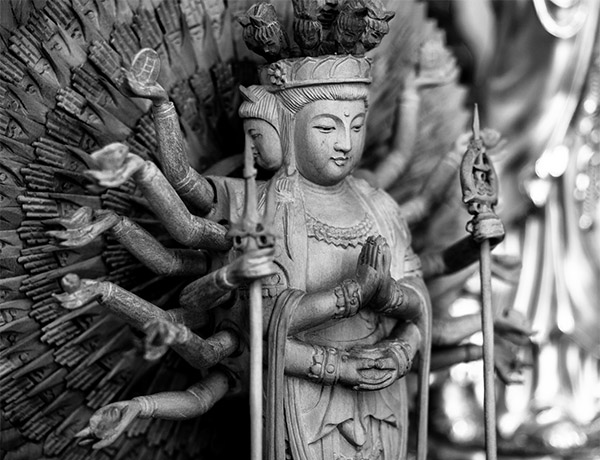
Tùy theo mỗi truyền thuyết, cũng có kịch bản kể rằng Quan Âm Bồ Tát có một nghìn cánh tay và một nghìn con mắt. Có lẽ là để giúp đỡ tất cả chúng sinh đang chịu khổ ở thế gian, cho nên mới cần nhiều tay như vậy.
Cứu giúp thôn làng
Có rất nhiều câu chuyện kể về Quan Âm Bồ Tát hóa thân thành người thường để giúp đỡ chúng sinh gặp khổ nạn. Tại một số địa khu, Quan Âm Bồ Tát được phác họa với hình tượng mang theo một chiếc giỏ và được tôn kính là vị thần bảo hộ cho các ngư dân và thủy thủ.
Có truyền thuyết kể rằng, ở một ngôi làng ven sông đầy rẫy những kẻ xấu, nhìn thấy dân làng gặp nạn, Quan Âm Bồ Tát bèn hóa thành một nữ ngư phủ xinh đẹp ghé thăm ngôi làng. Kẻ cầm đầu nhóm người xấu phải lòng nữ ngư phủ ngay từ cái nhìn đầu tiên, hắn ta muốn cầu hôn nàng. Quan Âm Bồ Tát yêu cầu hắn ta học thuộc kinh Phật, không ăn thịt và làm việc thiện. Cuối cùng, tất cả những kẻ xấu đã vứt bỏ vũ khí, thành tâm hối cải. Sau đó, sự bình yên đã trở lại với thôn làng, ngôi làng này cũng được biết đến là miền đất của lòng từ bi.
Giải cứu Đường Tăng và Tôn Ngộ Không
Quan Âm Bồ Tát cũng là một nhân vật quan trọng xuất hiện trong “Tây Du Ký”, một trong “tứ đại danh tác” của văn học cổ điển Trung Quốc. “Tây Du Ký” kể về hành trình thỉnh kinh của pháp sư Tam Tạng. Tiểu thuyết này được viết bởi tác giả Ngô Thừa Ân vào thế kỷ thứ 16. Đây là bộ tiểu thuyết phiêu lưu mạo hiểm vừa có yếu tố hành động hài hước, vừa chứa đựng những bài học về tu luyện. Shen Yun đã cải biên khá nhiều phân đoạn trong “Tây Du Ký” để đưa lên sân khấu.
Mở đầu tiểu thuyết “Tây Du Ký”, Quan Âm Bồ Tát đã chỉ dẫn cho Hoàng đế kêu gọi người đi thỉnh kinh Phật. Sau đó, bà đã an bài cho Tôn Ngộ Không, Trư Bát Giới và Sa Ngộ Tĩnh làm đồ đệ của Đường Tăng. Ý định ở đây là gì? Chính là để ba đồ đệ này lập công bù đắp cho tội lỗi đã phạm trên Thiên thượng, bảo vệ Đường Tăng thoát khỏi nguy hiểm, và điều quan trọng nhất là tinh tấn tiến bước trên con đường tu hành.
Xuyên suốt cuộc hành trình, ba đồ đệ đã diệt trừ tà ác, bảo vệ Đường Tăng. Mặc dù Tôn Ngộ Không rất lợi hại, nhưng cũng có lúc bị mất phương hướng. Mỗi khi Ngộ Không bối rối và bắt đầu bứt lông của mình, Quan Âm Bồ Tát liền xuất hiện và chỉ cho Ngộ Không cách giải quyết. Đây là lý do vì sao mọi người tôn kính Quan Âm Bồ Tát như vậy.
Quan Âm Bồ Tát đại từ đại bi, bất kể là vấn đề gì, bà đều có thể giải quyết. Nhưng hãy nhớ, bà chỉ giúp đỡ những người lương thiện, trung thực và nhân từ.
Trung Quốc cổ đại là mảnh đất nhân và Thần đồng tại, đã sáng tạo ra nền văn hóa Thần truyền. Do đó, lịch sử thuở sơ khai của Trung Quốc gắn liền với những câu chuyện thần thoại. Loạt bài mới “Câu chuyện thần thoại” của chúng tôi sẽ giới thiệu với các bạn về những nhân vật chính trong các truyền thuyết ly kỳ của Trung Quốc.
December 9, 2016


